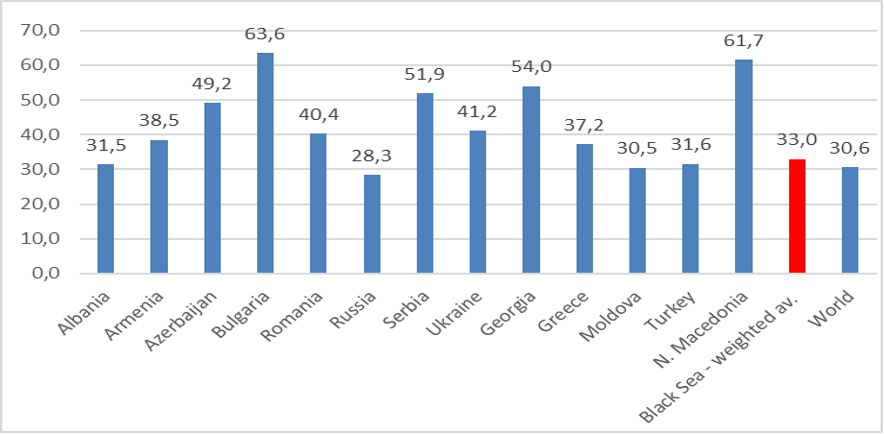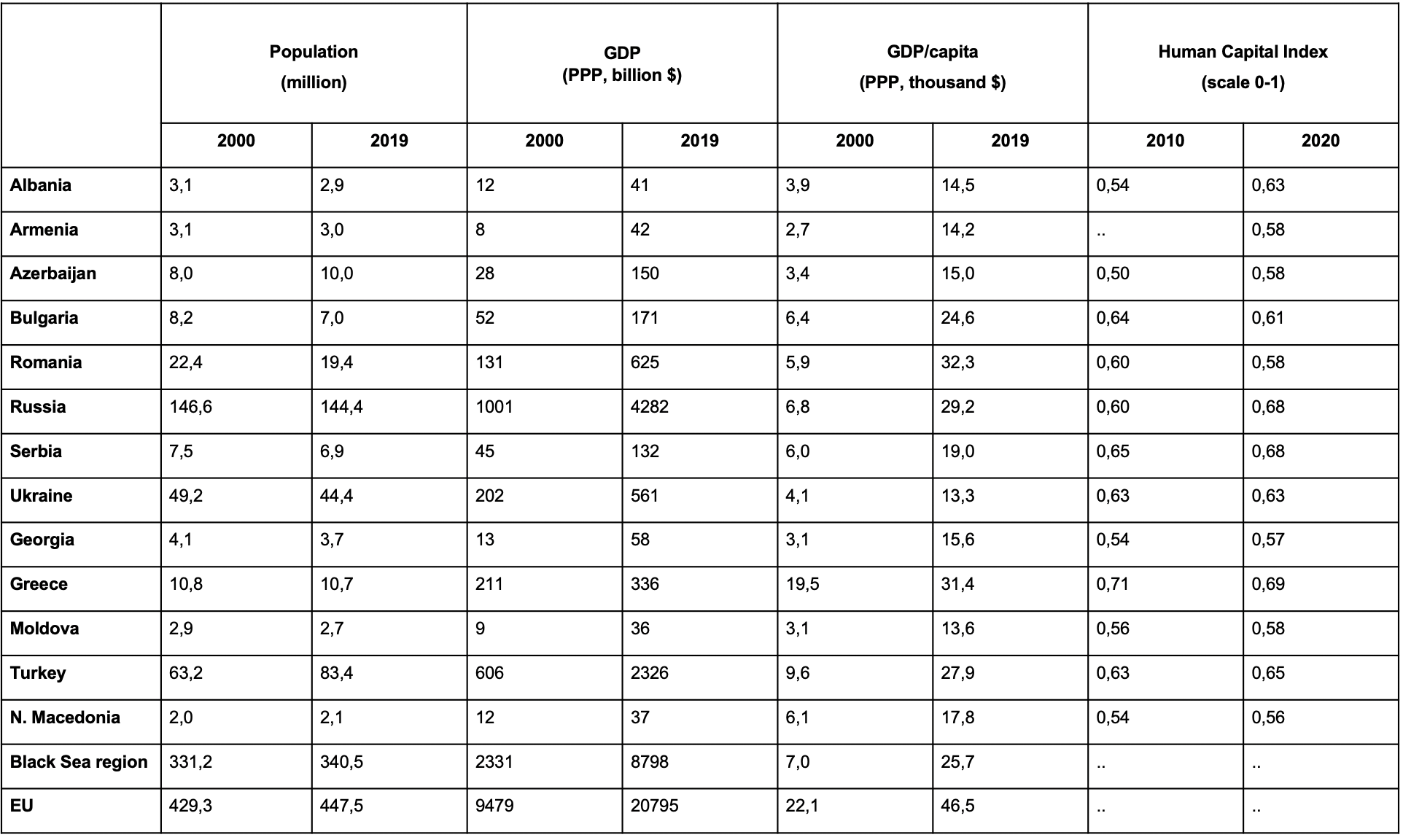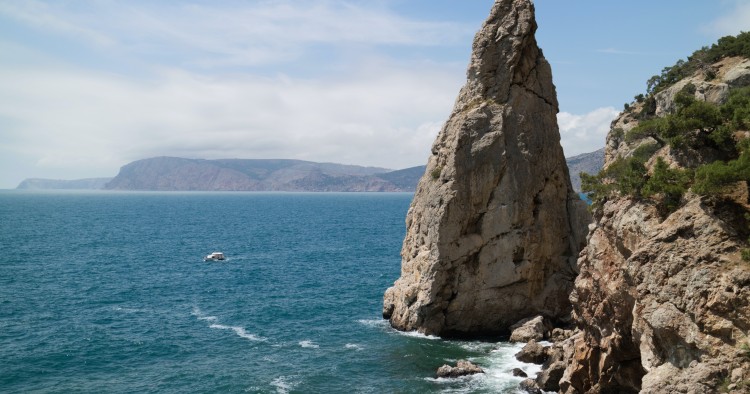With declining multilateralism, countries around the world are increasingly engaging in regional cooperation to deepen economic integration and take advantage of the benefits of global trade. Since the conclusion of the Uruguay Round of multilateral trade negotiations in 1994 - during which 123 participating countries agreed to the biggest reform to the global trading system since World War II and founded the World Trade Organization (WTO) - regional trade agreements have been the primary way for nations to liberalize their foreign trade. And, with the failure of the Doha Round of WTO negotiations in advancing any additional multilateral liberalization in the mid-2000s, combined with ongoing U.S.-China tensions, regionalism looks likes it is here to stay. There are currently 305 functioning regional trade agreements that make up the global competitive landscape.
Countries in the Black Sea region have largely failed to integrate with their neighbors, despite common levels of openness and dependence on foreign trade. For many countries in the region, trade has become a driving force for growth, accounting for on average one-third of regional GDP. However, Black Sea supply chains largely connect the region to the outside world, primarily Europe and Asia, instead of neighboring countries. Highly integrated trade relationships, like those seen in Southeast Asia, simply do not exist amongst Black Sea countries.
One reason for this could be heterogeneity. Regional integration is facilitated when participating countries possess a high degree of similarity, including geographical, economic, political, and cultural factors. However, the Black Sea is distinct because of the region’s differences, not its similarities. Black Sea countries are bound by their physical proximity, but they differ greatly in terms of territory, population, economic structure, and political orientation.
Another challenge is identity. There is no widely agreed definition of the Black Sea’s identity. The region is most commonly viewed as a combination of the six littoral states: Bulgaria, Romania, Ukraine, Russia, Georgia, and Turkey. However, from an economic standpoint, this definition ignores adjacent areas that are linked together by stronger trade or economic ties like Azerbaijan and Armenia’s ties to Georgia, or Romania and Bulgaria’s ties to the Western Balkans. Another possible way of categorizing the region is participation in regional organizations. The Black Sea Economic Cooperation (BSEC) is one example, but alongside the six littoral states, membership also includes Armenia, Azerbaijan, Moldova, Greece, Albania, Serbia and the candidate North Macedonia.

Ultimately, the region’s vast socio-economic potential is limited by several frozen conflicts which prevent political cooperation and a regional identity from forming. If true integration is to be achieved, regional adversaries and various hot and frozen bilateral conflicts must be overcome. Ethnic conflicts in Abkhazia, South Ossetia, Nagorno-Karabakh, and Transnistria, as well as the Russian annexation of Crimea and ensuing violence in the Donetsk and Luhansk regions, have turned the Black Sea basin into an area of growing antagonism and instability. Full-fledged economic cooperation is limited by confrontation, historical tensions over borders, autonomy and self-rule, competing geopolitical interests, great divergence among states, and a lack of common vision, mutual understanding and trust.
Black Sea littoral states are home to a population of over 302 million people while the population of adjacent countries exceeds 340 million. This is a large market by any measure - larger than the United States and equating to approximately 75 percent of the EU single market. With this market size, the possibilities for economies of scale and productivity gains are nearly endless.
A significant competitive advantage of the Black Sea region, although not fully exploited due to its fragmentation, is its geo-strategic position. The region represents a natural bridge between Europe, the Middle East, and Central Asia. Along sectors like energy, transportation, tourism, and communications, the region is attractive for investment in manufacturing and can offer access to a huge market.
Furthermore, over the last two decades, the wider Black Sea area has transformed into one of the most dynamic regions in the global economy. Currently, Black Sea countries have a GDP of $8.8 trillion, nearly four times greater than 20 years ago. Standard of living has significantly improved during the same period. The average GDP per capita of the wider Black Sea region measured at purchasing power parity is $25,700, 55 percent of the EU average in 2019, up from 32 percent in 2000. While significant intra-regional disparities still exist, this growth has happened in spite of continued regional sectarian movements, violence, and Russian intervention.

As regional leaders look to tap into opportunities for externally led growth through economic integration, they need to do so while also leveraging the region’s existing strengths. For example, countries of the Black Sea are home to a relatively healthy and well-educated work force compared to global peers. During the last decade, a majority of countries from the wider Black Sea region have improved or sustained their relatively high performance in the World Bank’s Human Capital Index (HCI).
Furthermore, while there are large disparities and some countries are heavily energy import-dependent, the Black Sea region is one of the most resource-rich in the world. This presents a unique trade complementarity that would thrive with greater regional cooperation, ensuring reliable supplies for the resource-poor and steady demand for the resource-rich countries.
A major political and economic divide in the Black Sea region exists between EU-orientated states and Russia (EU members in the region are Greece, Bulgaria, and Romania; candidates for membership are Albania, North Macedonia, Serbia, and Turkey; associate countries are Georgia, Moldova, Ukraine). Armenia wishes to actively collaborate with both the EU and Russia, especially on trade issues, but was forced to sacrifice closer ties with the EU and abandon Association Agreement negotiations in order to join the Russian-led Eurasian Economic Union (EAEU) in 2015. In contrast, Ukraine preferred to forgo traditional trade and economic relations with Russia and bind its economy with the much more technologically advanced EU by signing a Deep and Comprehensive Free Trade Agreement. Unable to attract Ukraine to the EAEU and having lost a geo-economic competition with the EU, Russia likely felt its geopolitical interests were threatened. This could have been the catalyst for its aggression in Crimea and Ukraine’s eastern provinces.
The EU has always been a decisive factor in Black Sea regionalism. While it has stimulated intra-regional cooperation through various programs and projects under the Black Sea Synergy Initiative, the EU’s own institutions monopolize trade negotiations, preventing countries on the periphery who participate in the EU or the Customs Union from pursuing independent trade policies with external regional partners. Black Sea countries have generally perceived intra-regional cooperation as less advantageous than European economic integration. Even BSEC, the most likely forum for further regional integration, prioritizes European integration over regionalism within the area. From the outset, BSEC participants declared that economic cooperation would be developed in a manner that didn’t prevent enhanced relations with third parties, including the EU. As a result, BSEC has not promoted preferential trade liberalization (the formation of a free trade area or a customs union) among its members, while its activities have largely been limited to technical consultations.
For most countries in the Black Sea, the EU has positioned itself as the largest trading partner and foreign investor, and an important source of technical assistance. It is in the interest of the EU that this geostrategic region, which represents a major commercial route linking Europe with Central Asia and the Middle East, is secure, stable, and prosperous. To ensure this stability and cooperative growth, the EU must show stronger leadership and help balance various interests in order to encourage much-needed regional integration.
Causality can run in the opposite direction, too. Intensifying trade and economic interdependence could be the most effective strategy towards achieving long-term stability and security in the region. EU leadership, including concrete steps towards facilitating regional economic cooperation, could help restore worsening bilateral political relations among some of the Black Sea countries.
To capitalize on their many regional competitive strengths, Black Sea countries must realize the benefits of regional integration and gradually begin building a common regional identity. The appeal of the region as a peaceful and stable destination for investment and important partner in the global economy will rise once economic reasoning supersedes political factors and cooperation replaces confrontation.
Paskal Zhelev, Ph.D. is a Black Sea fellow with MEI's Frontier Europe Initiative and an Associate Professor of International Economic Relations at the University of National and World Economy (UNWE) in Sofia, Bulgaria. The views expressed here are his own.
Photo by Vyacheslav Argenberg
The Middle East Institute (MEI) is an independent, non-partisan, non-for-profit, educational organization. It does not engage in advocacy and its scholars’ opinions are their own. MEI welcomes financial donations, but retains sole editorial control over its work and its publications reflect only the authors’ views. For a listing of MEI donors, please click here.













